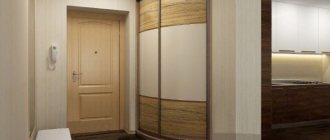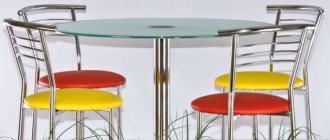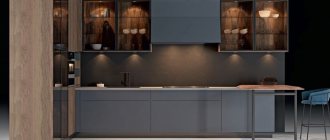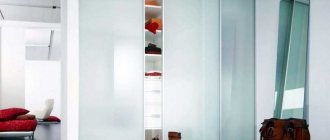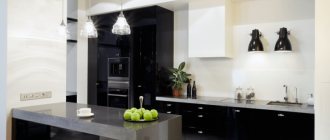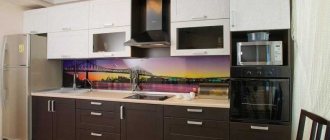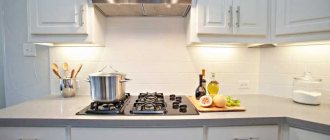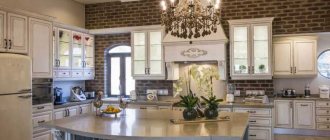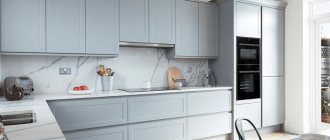2019-06-13
Author: Belfan
From this article you will learn:
- How buffets came to be
- What is good about a buffet in a kitchen interior?
- What types of kitchen buffets are there?
- What styles of kitchen buffets are available?
- What materials are used to make a kitchen buffet?
- How should the kitchen buffet be filled?
- How to decorate a kitchen buffet
- How design ideas can be applied to a buffet
- How to choose a buffet for the kitchen
- How to make a kitchen buffet with your own hands
A buffet or sideboard usually evokes associations with Soviet or country cuisine. However, this piece of furniture can organically fit into the modern interior of your home. Manufacturers offer many interesting models of buffets. We will tell you in our article about what a kitchen buffet can be and how to choose it so that it does not look like a relic of the past.
The history of buffets
The first buffets appeared in France at the beginning of the 15th century. Rich nobles kept expensive dishes made of porcelain and silver in them. The closet usually had two compartments with doors that were locked.
The word "buffet" comes from the Latin "bufetum", which means "brilliant table".
In the 17th century, the appearance of sideboards underwent changes, and they became similar to modern furniture. In the upper part of the cabinet there were open shelves for plates and glasses (with or without doors), in the middle there were drawers for cutlery, and in the lower part there were shelves with blind doors for heavy dishes.
Between the middle and lower compartments there was a tabletop. It was used to prepare dishes before serving and for preparing light snacks. This is where the second meaning of the word “buffet” comes from – a place for a snack.
The French buffet was so convenient that wealthy people from other European countries also began to buy similar furniture for themselves. Later, such kitchen cabinets appeared in the homes of the middle class.
Recommended articles on this topic:
- Solid wood buffet as a symbol of comfort and warmth in the home
- Classic style bedroom: design secrets
- Classic style sofas are fashionable and stylish
In Russia, they used an analogue of the European buffet - a massive cabinet on metal legs in which samovars, jam and containers for heating water were stored.
During Soviet times, the buffet became lighter and more similar to Western models.
Modern sideboards and buffets for the kitchen come in different sizes, colors and designs, but their design is practically no different from the original French version.
What is good about a buffet in a kitchen interior?
The main purpose of the buffet is to store dishes, forks, spoons, knives, tablecloths, napkins, salt shakers and other table serving items. Such a cabinet can be placed not only in the kitchen, but also in the living room.
So, as mentioned above, the classic design of a buffet consists of three compartments:
- in the lower part there are drawers or shelves with doors;
- in the top there are open shelves with or without glass doors;
- between two compartments there is usually free space, which is used as a tabletop or decorated with souvenirs and other interior items (vases, figurines).
Modern kitchen sideboards are rarely overloaded with decorative elements, so they easily fit into different style trends: minimalism, hi-tech, country, modern, Provence.
Today they also create buffets without a clear division into upper and lower parts, that is, there is no tabletop in such models.
There are no uniform standards and sizes of modern buffets. There are narrow ones with one door and wide ones with several doors. You can buy a ready-made buffet or make it to order according to your parameters, based on the height of the ceilings, kitchen area and personal wishes.
Advantages of a kitchen buffet:
- Capacity. Everything will fit: from grandma’s set for 20 people to a crystal vase or a collection of glasses.
- Versatility. Fits into any interior and adds zest to the space.
- Environmental friendliness. Sideboards are usually made from wood.
- Individuality. You can make it to order or choose in the store the model that will satisfy all your needs.
Open buffet models
Opened buffets do not have doors in the upper compartment of the structure.
- Most often, the upper section consists of shelves, glass holders, and baskets.
- The main disadvantage of this design is the accumulation of dust.
- Such storage systems are intended for regular use.
- For example, for storing dishes used daily.
Types of buffet for the kitchen
By design, buffets are:
- Closed type - with shelves closed by doors. There are cabinets with small windows through which the contents are visible.
- Open type - with shelves, but without doors. Maybe with a tabletop.
- Classic type - there is an upper part with shelves and glass doors, a lower part with blind doors and a niche or tabletop between them.
According to the shape of the frame, the buffet can be:
- straight - a traditional rectangular model that can be placed along the wall;
- corner - a buffet for the kitchen in the form of the letter L or trapezoid. Such a cabinet fits only in the corner of the room. If the design of the kitchen unit is dominated by smooth lines, then models with a radius facade are suitable.
Closed structures
Closed versions always have doors, but not necessarily with solid doors. They can have windows made of glass or mesh material. In such storage systems, dust ingress is reduced to zero. Which is conducive to storing expensive holiday services.
Sideboards with solid doors look massive, so glazed options are better suited for miniature kitchens.
Kitchen Buffet Styles
- Classic style.
These are carved solid wood cabinets with etched or glass doors. The fittings (legs, handles) are curved.
- Retro style.
This is either an antique buffet or a modern one, but artificially aged. To make the cabinet even more authentic, they use decoupage techniques, paint it in light shades and add patina.
- Provence.
A cabinet with stained glass doors, made from modern materials, but with an antique effect. It is appropriate to use patina, decoupage, carvings, and flower images in decoration.
- Country.
Such furniture is made from solid wood. A country style buffet looks solid and even bulky. Simple forms predominate, without unnecessary decoration or frills. Focus on functionality: many drawers of different sizes for any kitchen utensil.
- Scandinavian style.
The traditional color of a Scandinavian buffet is white. The laconic design allows the use of chrome fittings. In addition to wood, glass, plastic, acrylic or other modern materials are used in the manufacture of buffets.
- Modern.
Such buffets are made in light pastel colors. The decor contains decorations in the form of carvings, ornate patterns and ornaments. Smooth lines, plant compositions and semicircular shapes are popular.
- High tech.
A characteristic feature of the style is clear lines and the absence of decorative elements. The fronts of a kitchen buffet in this style use metal inserts and glossy glass.
Blue, green, yellow or white sideboard for the kitchen?
A blue classic wardrobe is the choice of extraordinary individuals and fans of nautical style. It looks attractive, calms, and makes the kitchen bright and original. Buffets with greenish, sage shades are called “chameleons”: they change color in different lighting and in any case belong to the basic ones. Such tones advantageously complement others, rather than dominate.
A white buffet is associated with traditional cuisine. Pairs especially well with black stone countertops. Bright yellow products make the interior luxurious. For a vintage feel, cabinets feature wrought iron handles in a warm buttery color paired with marble countertops. But buffets made from pale green and yellow tones will give the kitchen or living room a playful, unusual mood.
In such a room it is always cozy, easy, negative emotions fade into the background.
If you are conservative, go for gray. Yellow chairs and gilded decor will help make it more expressive.
What materials are kitchen buffets made from?
- Valuable species of natural wood.
This buffet looks expensive and will last for several generations of the family. The price, of course, will be above average. The facades are usually decorated with carvings. It is important that the frame and facades are treated with high-quality moisture-resistant materials.
- MDF and chipboard.
These are more budget-friendly materials, but also less durable. However, due to the relatively low cost, products made from them are in certain demand on the market.
You can also find kitchen buffets made of plastic or metal.
Stocking the buffet in the kitchen
The internal content of the buffet depends on the needs of the owners. You can choose the required combination from the basic elements:
- Shelves: open ones are for decorative items, closed ones are for dishes and cutlery.
- Deep drawers for tablecloths, plates, pots and pans.
- Flat drawers - for forks, spoons, knives.
In modern buffets, you can choose different door designs. In the classic version, these are swing doors that open outward. There are also sliding doors (like in wardrobes) and folding doors (like a book or accordion).
For upper shelves it is more convenient to use folding doors with lifting mechanisms - spring or gas lifts.
Where is the best place to place a buffet in the kitchen?
There are no clear recommendations where the buffet should be. It all depends on the size of the room and the arrangement of other furniture. The buffet can be used to zone the space. In a studio apartment, it will become an original delimiter between the work area and the place to relax.
If the sideboard is part of a furniture set, then it is better to place it next to other items. Typically, such sets also include a table and chairs. Traditionally, they are placed in the living room or kitchen (if space allows).
If the kitchen is small (less than 5-9 m2), then a free-standing buffet will not fit in it. It is better to choose a built-in option in the kitchen set.
There are free-standing small buffets for the kitchen. Most often these are expensive antique models. They act as a decorative element and are rarely used for their intended purpose.
In a studio apartment you can make a buffet bar. It will organically combine the work area with a place for eating.
Where to install the buffet?
One of the most logical and therefore popular locations of a buffet is in the kitchen space as a continuation of the furniture set. In this case, the buffet can be installed along the wall and continue the kitchen ensemble, or have a perpendicular location and outline the boundaries of the functional sector.
Most often, dishes, cutlery and other serving items are stored in the buffet, so it is most logical to place this piece of furniture near the dining group. The table for meals can be located in the kitchen space or be the focal point of a separate room - the dining room. Regardless of the installation of the dining ensemble, a buffet can accompany it in any area.
Another option for installing a buffet or sideboard is on the border of functional areas. This can be either an element of zoning the kitchen into a dining and work area, or part of a combined room in which three functional segments are located at once - kitchen, dining room and living room. In the case of zoning a large space, the buffet can be located either along the wall or perpendicular to the vertical plane, clearly separating the kitchen work area from the dining room or living room.
In some cases, it is more rational to use two narrow cupboards rather than one bulky cabinet. In this case, a pair of sideboards can be located on two sides of a window or doorway, or any other interior element. Obviously, such an arrangement will not only help to rationally use the usable space of the dining room or kitchen, but will also emphasize the traditional style with symmetry.
If there is a niche in your dining room or kitchen, then not using it to install a buffet is simply a sin. Finding a ready-made furniture solution for the existing niche dimensions will not be easy, but making a custom-made buffet to suit your requirements will solve not only the problem of dimensions, but also stylistic execution.
In some rooms, the buffet is not connected either to the kitchen unit or to the dining group. Any free space in a spacious room can be a good installation option. Of course, it is desirable that this sector is not remote from the dining area - it is more convenient to set the table if all the items are “at hand”.
Buffet decor for the kitchen
Depending on the style of the buffet, different types of decor are used:
- carving - patterns carved into wood;
- engraving – patterns applied to metal or other hard material;
- glazing – for upper facades. If you need to hide the contents of the cabinet, the doors are made not transparent, but darkened or a stained glass pattern is applied.
Kitchen Buffet Design Ideas
You can make a buffet in the same style as the kitchen set. To ensure that the cabinet does not stand out from the rest of the furniture, all finishing elements must match: facades, color palette, fittings, decor. If you need to zone the work area, place the buffet perpendicular to one of the sides of the set.
A kitchen design with a buffet may require visual highlighting of the cabinet. There are two options for how to place accents in the interior: unobtrusively or brightly. In the first case, the cabinet is made in the same color, but in a different style than the kitchen set, or they use a single color palette, but a different external design. All furniture in the kitchen can be white, and the buffet can be cream or milky. Either the set has matte facades, while the sideboard has glossy facades.
If you need to make a bold accent in the kitchen interior, then it is better to choose a bright, colorful buffet. This could be a retro model made of natural wood or a modern cabinet in high-tech or modern style. All other furniture in the room should be neutral in color so as not to draw attention to itself.
Another option is to match the look of the buffet to the style and color of the furniture in the living room or dining room. It can be the same type of wood as the dining table. Or so that the shade of the cabinet front matches the color of the backs of the chairs. Perhaps the milling of the sideboard echoes the lines on the legs of the rest of the furniture.
In some buffet models, the central part is intended for a workplace. The compact tabletop is convenient for placing a small laptop or desktop computer. Such a multifunctional cabinet, which serves not only as a cupboard for kitchen utensils, but also as a mini-office, is convenient to install in the dining room or living room.
Designers love to use sideboards with history in modern interiors. Cracks, chips and other external defects are not a problem for them. Quite the contrary. Often they are not disguised, but deliberately emphasized in order to emphasize the antiquity of the cabinet. Modern buffets in a classic style can be specially aged to add solidity and prestige to them.
For those who do not like large bulky cupboards for dishes, a display cabinet is suitable. It has enough space to store plates, tea sets and cutlery. The only drawback is that all the compartments have glass doors and the dishes are visible to everyone. The display case is not divided into upper and lower parts, as in a classic buffet.
If the kitchen area allows, you can make an alternative buffet in the form of a kitchen island. The lower part with closed shelves and the external design of the facades are taken from the china cabinet. All the advantages of a convenient storage system for kitchen utensils are preserved. The result is an original modern work area, on the countertop of which you can cook, and in the drawers and compartments you can keep everything you need at hand. This piece of furniture will fit in a spacious kitchen, which is a separate room or combined with a dining room or living room. For the convenience of working behind such a buffet, you can provide a curved shape of the facades.
Does the USSR buffet look natural in a modern kitchen?
If you have a maximum of two vintage items in your room, yes. Good options: a combination of a retro floor lamp and an armchair, a dining set for sleeping or dining with a dressing table, which will sit comfortably in the corner. Soviet furniture is organic in retro, minimalism, loft, as well as Scandinavian, classic styles and Provence.
A Provence kitchen always has a large wooden buffet. It can be turquoise, beige, olive or lilac.
It is often painted, and the surrounding space is filled with soft wooden retro chairs and a massive table. Furniture made from fiberboard from the times of the USSR is often restored using decoupage cards, opaque paint, and film with a pattern. If there are no scratches or cracks, simply periodically polish and replace the fittings.
How to choose a buffet for the kitchen
Each person will have their own buffet to their liking. Some people need, first of all, roomy, others – antique, and others, on the contrary, in accordance with the latest trends in the interior. But let’s highlight the main parameters that you should focus on when choosing a buffet:
- Style.
It is more correct to first draw up a design project for the kitchen or the entire apartment in order to understand what kind of interior you will have, and only then choose a buffet. If it is not possible to hire a designer, just look through catalogs or look at thematic websites to decide which style trends you like. Pictures can be saved to Pinterest, your phone, or your desktop.
Having decided on the style, you can choose furniture. Of course, you don’t have to do any preliminary preparation, but simply go to a furniture store or look for a kitchen buffet in an online store. But in this case, you risk buying furniture of completely different designs. Some people manage to successfully mix different styles in one interior. Therefore, it is better not to take risks, otherwise you may end up with an “expensive-rich” option, but not at all stylish.
- Dimensions, internal contents, functionality, materials from which the buffet will be made.
Decide what dishes and how many you want to store in the cabinet. How many open and closed shelves do you need? How tall should the boxes be? Do you need a countertop?
- Dimensions of the buffet.
They are different:
- width – from 120 to 200 cm;
- depth – from 40 to 60 cm;
- height – from 180 to 200 cm.
For a small kitchen, you can also find more compact models - 80-120 cm wide.
Purpose, advantages and disadvantages of a kitchen buffet
Essentially, what is a buffet? Cabinet for storing kitchen appliances, dishes and textiles. It can be open or closed, of different sizes, with a large or small number of compartments.
Among the advantages of such a cabinet:
- Convenience. Everything is at hand. There are models with an impromptu table on which you can place plates and cups before serving, cut something small, and brew tea.
- Capacity. Despite their compactness, buffets are usually very spacious. They have a lot of shelves for food, services, and a variety of drinks.
- Versatility. The choice is huge, so you can safely use it in different rooms and styles.
The disadvantages are high prices for quality products and bulkiness. Let's say right away that in many cases the cost is justified, because this item is purchased for decades. Large dimensions are not a hindrance for a spacious kitchen or living room; in addition, small models are now being produced.
Read more about the buffet for the kitchen in Provence style
If the kitchen interior is designed in the same Provencal style, it is not necessary to choose a sideboard that matches the rest of the furniture. It may be slightly different, but it is better to avoid sharp contrasts. After all, Provence is characterized by a calm pastel color palette.
The upper shelves of the buffet can be open or with glass doors. They are convenient for storing cups, decorative plates, spices in beautiful jars, stylish boxes of tea and memorable souvenirs.
On the closed lower shelves there is space for large dishes: pots, pans, tall jugs and glass jars. To combine the style of the buffet with the kitchen set, you can choose the same countertops for them.
Restoration of a kitchen buffet
If you are lucky and received an antique sideboard from your relatives, you can restore it yourself and adapt it to the interior of your apartment. Designers offer practical advice on how to do this effectively and easily with your own hands:
- Paint an old sideboard a bright color that complements your decor.
- A natural wood buffet needs to be varnished. Paint is not suitable here, as it “cheapens” the appearance of antique furniture.
- Paint the outside of the cabinet with paint in neutral shades (for example, pastel, like in the Provence style), and choose bright rich colors for the interior decoration. This will look especially impressive at the top of a buffet with glass doors.
- Create the effect of antiquity during the restoration process. There are different techniques for artificial aging: surface treatment with sandpaper, coating with craquelure varnish or using decoupage techniques.
Before applying any finishing (paint, varnish, etc.), be sure to prepare the surface of the cabinet. First you need to sand it thoroughly, then sand it, wash it with soap and apply a primer.
The most suitable buffet for a small kitchen
As a rule, buffets are installed in rooms with a large area, but there are many exceptions to the rules. Manufacturers offer a good selection of compact models, and designers offer methods for visually expanding space.
Small cabinets will look best in a corner or against a wall, so they won't take up precious square footage and won't seem bulky. As for color, experts recommend blue tones. They refresh, calm, brighten and enlarge the room.



